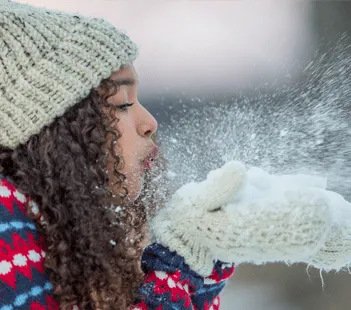January 01, 2017

Winter Sports Injury Prevention Tips: Frostbite
It only takes a few minutes for exposed skin to become frostbitten if the temperature is below 20 F and the wind is blowing at 20 mph or more.
What is Frostbite?
When outside in the cold, your body is focused on maintaining its core temperature. To do that, it shifts blood away from the extremities and toward the central organs of the heart and lungs. This increases the risk of local cold injury such as frostbite to your arms and legs.
Body tissues actually freeze when they are frostbitten. Ice crystals form in the cell, causing physical damage and permanent changes in cell chemistry. When the ice thaws, additional changes occur and may result in cell death.
If just the skin surface is affected, it's known as superficial frostbite; deep frostbite affects underlying tissues.
Preventing Frostbite
Anyone who is not dressed properly, is outside for too long, or gets wet in cold weather can get frostbite. Children and seniors are especially at risk. People with circulation problems, including diabetics and people with atherosclerosis, those with a previous injury, or people taking certain drugs such as alcohol, nicotine, or beta-blockers (which decrease the flow of blood to the skin) are also at risk. It is easier to prevent frostbite than to treat it.
- Dress for the weather. Wear light, loose, layered clothing that provides ventilation and insulation. Wear a water-repellent coat on top.
- Protect your head, hands and feet. Much of your body's heat loss occurs through your head and extremities. Mittens are warmer than gloves. Wear two pair of socks and boots to keep your feet warm.
- Don't drink or smoke before going out into the cold. If you plan on being out in the cold for a prolonged period, don't drink or smoke. Alcohol, caffeine and nicotine leave the skin more prone to thermal injury.
- If you get wet, go inside. Remove wet clothing as quickly as possible. Check yourself every half-hour or so for signs of frostbite. If your toes, fingers, ears or other body parts feel numb, get inside.
Symptoms
- Numbness
- Skin feels frozen
- Skin appears waxy, white, or grayish.
- Numbness
Frostbite is very serious. If you suspect you have frostbite, seek medical care immediately. People who have frostbite sometimes develop hypothermia, which requires emergency medical assistance. Call 911.
You can help by...
- Getting the person into a warm room as soon as possible.
- Calling for medical assistance. You can also give the person warm drinks, such as broth or tea.
- Resting the injured areas.
- Avoiding walking on frostbitten feet.
- Elevating the part slightly.
- Taking off wet or restrictive clothing.
- Warming the area by immersing it in warm water (not HOT water) for at least 30 to 45 minutes, or until the affected part feels warm and sensation returns. During warming, the patient may complain of severe pain and the injured area may swell and change color.
Avoid...
- Doing anything that will further injure the tissue.
- Rubbing the area with your hands, with snow, or with anything else. Leave blisters intact, and cover them with a sterile or clean cloth.
- Using dry heat, such as from a heating pad, blow dryer, sunlamp, fire, or radiator, to try to warm the area. Be careful not to burn the skin. Because the skin is numb, it will not feel the heat.
- Doing anything that will further injure the tissue.
Source: American Academy of Orthopaedic Surgeons; Consumer Product Safety Commission
Download Frostbite Prevention & Safety Tips PDF
© 2012 Denver Health


